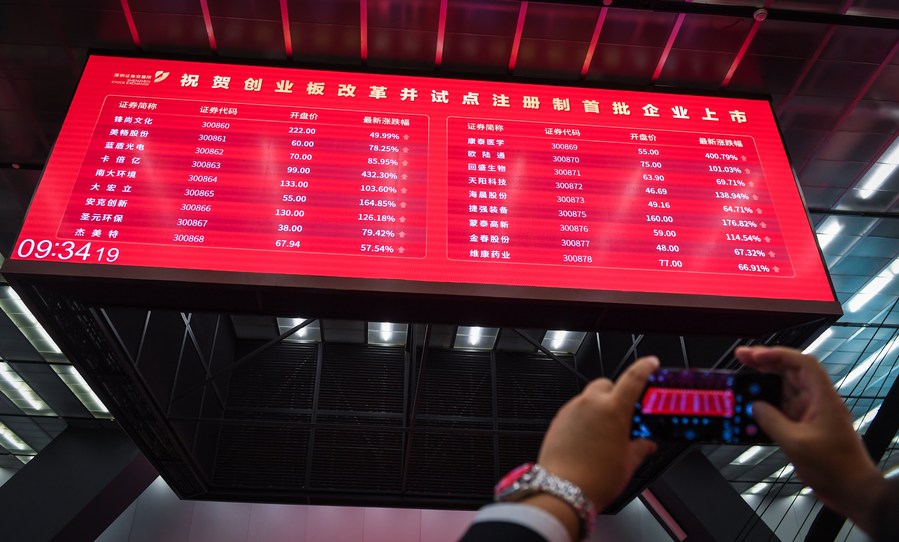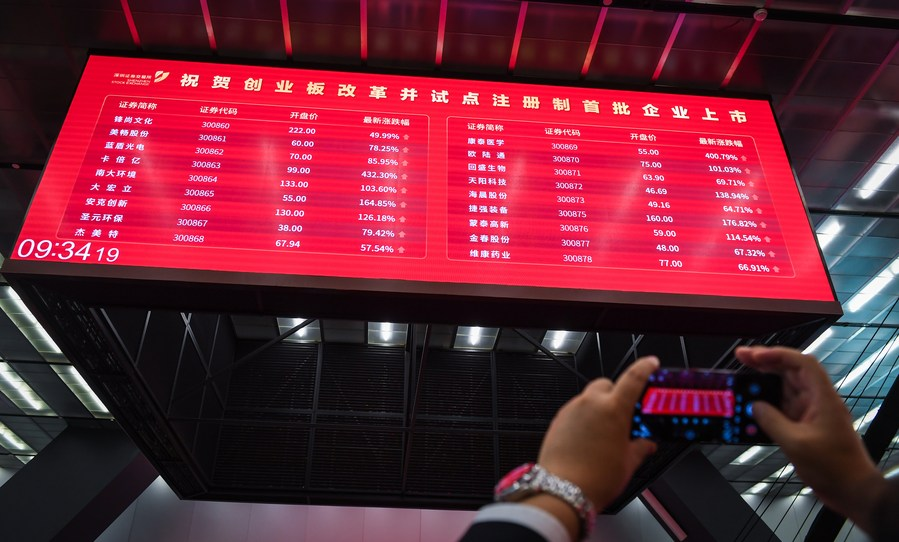
A man takes photos of a big screen displaying stock prices at the listing ceremony of the first batch of registration-based initial public offerings (IPOs) of enterprises debuted on the ChiNext board at Shenzhen Stock Exchange in Shenzhen, south China's Guangdong Province, Aug. 24, 2020. (Xinhua/Mao Siqian)
BEIJING, Aug. 19 (Xinhua) -- China's renminbi (RMB) assets continue to be attractive to foreign investors thanks to the country's stable economy, high-potential assets and optimized capital market mechanism, according to experts.
-- Sustainable and steady economic growth
From a macro perspective, the long-term attractiveness of a country's financial assets rests upon the sustainable and steady growth of its economy.
China has been the only economy with positive economic growth amid a global recession since 2020 due to the COVID-19 pandemic.
This hard-won achievement can be largely attributed to the country's full-fledged manufacturing system, which fuels its quick economic rebound, and allows the country to offer supports for other economies in epidemic prevention and economic recovery through steady foreign trade.
China's strength in the manufacturing sector is second only to Germany, according to an index compiled by the United Nations Industrial Development Organization(UNIDO).
In the first half of 2021, China's foreign direct investment (FDI), in actual use, totaled 607.84 billion U.S. dollars, up 28.7 percent year on year, among which that of the manufacturing sector has seen an increase of 9.9 percent, marking the highest growth in the past decade.
Moving from the stage of high-speed development, the country has shifted to a high-quality development pattern to secure a moderate economic growth.
China has long been dedicated to improving its industrial structure, with the tertiary industry taking a larger share in its gross domestic products (GDP). Along with the application of advanced technology in the primary and secondary industries, the thrived tertiary industry has enhanced the country's optimized industrial structure and created more jobs for the population.
Responding to the call of high-quality development, more efforts have been made to promote quality of the advanced manufacturing industry, empowering China to move up the ladder in the global industrial chain.
Since 2000, China's spending on research and development (R&D) has seen a fast upsurge, outpacing its economic growth. Its share in GDP also rose, reaching 2.4 percent in China's total GDP in 2020, with a total amount of 2.5 trillion yuan(about 385.5 billion U.S. dollars).
High-tech product export has also witnessed steady growth since 2000, accounting for 30 percent or so in the country's total exports in recent years.
-- Chinese assets with great potential
Apart from the country's economic fundamentals, China's financial assets themselves have been a magnet with their great potential.
China's indexes embody both growth potential and stability. On the one hand, they have long been underestimated compared to their overseas counterparts, thus indicating a large growth potential. Besides, China's flagship index CSI 300 has shown a far smaller range of fluctuation than other Asian indexes such as the Nikkei 225 Index and Korea Composite Stock Price Index.
In terms of stock market, investors at home and abroad have doubled down on investment in China's markets through financial infrastructures such as Shanghai-Hong Kong Stock Connect and Shenzhen Hong Kong Stcok Connect and Bond Connect.
Apart from March, when overseas stock markets tumbled, the A-share market has reported net capital inflows through northbound trading in every month so far this year.
In July 2021, net capital inflows through northbound trading, or money invested from Hong Kong into the Chinese mainland through the stock connect programs, has topped 10.76 billion yuan, according to data from financial information provider Wind.
China's bond market has also proved attractive on its high return. The yield of China's 10-year treasury bond is much higher than that of its American counterpart, with an average yield gap up to 1.2 percent since June 2010. It is also the same case in the yield of short-term treasury bond, with the average Chinese three-month treasury yield reaching2.57 percent, compared to 0.53 percent of its U.S. counterpart.
-- Improving capital market mechanism
Global investors have paid more attention to the sound capital market mechanism, effective protection for investors' interests and stock listing appeal for quality enterprises amid the increasingly fierce competition among global capital markets.
China began to further reform and open up its capital market, and improve relevant institutions following a key economic meeting in 2018, when a clear goal was posed to create a standardized, transparent, open, flexible, vigorous and resilient capital market. During the past years, China has gradually rolled out and updated laws and regulations concerning securities trading in a bid to better protect investors.
Meanwhile, China stepped up efforts to push forwards the registration-based IPO reform in the past few years, allowing the market to play a bigger role in deciding the pricing and value of innovative firms.
As China heads for a more enabling capital market, more enterprises from strategic emerging industries, such as 5G information technology, biotechnology, new energy, new materials, high-end equipment, new energy vehicles, environmental protection, tend to embrace rapid development by seeking IPO on China's stock market. For instance, among the IPO companies listed in 2019 and 2020, companies in sectors such as machinery, electronics, computers and medicine accounted for nearly half of the total.
The large-scale listing of emerging industries reflects the advocacy for the "new economy" and the continuous improvement of the market structure, which will in turn reinforce investors' investment return.
(Edited by Li Shimeng with Xinhua Silk Road, lishimeng@xinhua.org)




 A single purchase
A single purchase









